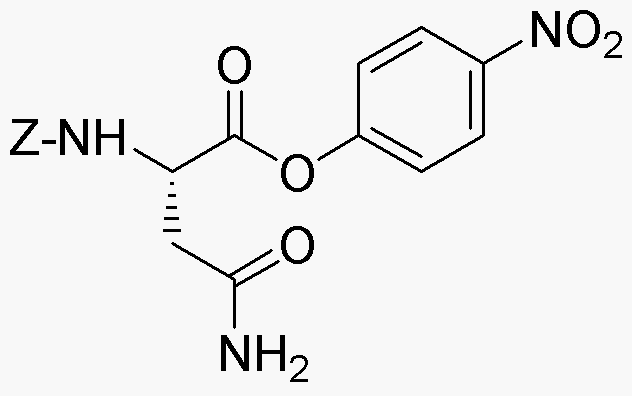Na-Z-L-asparagine 4-nitrophenyl ester is widely utilized in research focused on:
- Biochemical Research: This compound serves as a substrate in enzyme assays, allowing researchers to study enzyme kinetics and mechanisms, particularly in the field of proteomics.
- Drug Development: It is used in the synthesis of peptide-based drugs, providing a pathway for creating more effective therapeutic agents with improved bioavailability.
- Diagnostics: The compound can be employed in diagnostic assays to detect specific enzymes or biomarkers, aiding in disease diagnosis and monitoring.
- Food Industry: It finds applications in food science for studying protein interactions and modifications, which can enhance food quality and safety.
- Academic Research: As a versatile reagent, it supports various studies in organic chemistry and molecular biology, facilitating advancements in academic research and education.
General Information
Properties
Safety and Regulations
Applications
Na-Z-L-asparagine 4-nitrophenyl ester is widely utilized in research focused on:
- Biochemical Research: This compound serves as a substrate in enzyme assays, allowing researchers to study enzyme kinetics and mechanisms, particularly in the field of proteomics.
- Drug Development: It is used in the synthesis of peptide-based drugs, providing a pathway for creating more effective therapeutic agents with improved bioavailability.
- Diagnostics: The compound can be employed in diagnostic assays to detect specific enzymes or biomarkers, aiding in disease diagnosis and monitoring.
- Food Industry: It finds applications in food science for studying protein interactions and modifications, which can enhance food quality and safety.
- Academic Research: As a versatile reagent, it supports various studies in organic chemistry and molecular biology, facilitating advancements in academic research and education.
Documents
Safety Data Sheets (SDS)
The SDS provides comprehensive safety information on handling, storage, and disposal of the product.
Product Specification (PS)
The PS provides a comprehensive breakdown of the product’s properties, including chemical composition, physical state, purity, and storage requirements. It also details acceptable quality ranges and the product's intended applications.
Certificates of Analysis (COA)
Search for Certificates of Analysis (COA) by entering the products Lot Number. Lot and Batch Numbers can be found on a product’s label following the words ‘Lot’ or ‘Batch’.
Numéro de catalogue
Numéro de lot/série
Certificates Of Origin (COO)
This COO confirms the country where the product was manufactured, and also details the materials and components used in it and whether it is derived from natural, synthetic, or other specific sources. This certificate may be required for customs, trade, and regulatory compliance.
Numéro de catalogue
Numéro de lot/série
Safety Data Sheets (SDS)
The SDS provides comprehensive safety information on handling, storage, and disposal of the product.
DownloadProduct Specification (PS)
The PS provides a comprehensive breakdown of the product’s properties, including chemical composition, physical state, purity, and storage requirements. It also details acceptable quality ranges and the product's intended applications.
DownloadCertificates of Analysis (COA)
Search for Certificates of Analysis (COA) by entering the products Lot Number. Lot and Batch Numbers can be found on a product’s label following the words ‘Lot’ or ‘Batch’.
Numéro de catalogue
Numéro de lot/série
Certificates Of Origin (COO)
This COO confirms the country where the product was manufactured, and also details the materials and components used in it and whether it is derived from natural, synthetic, or other specific sources. This certificate may be required for customs, trade, and regulatory compliance.


